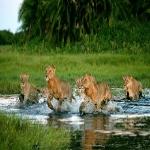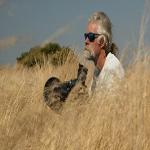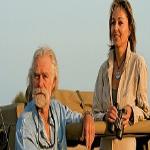February 22, 2011

Photo: National Geographic
Scene from "The Last Lions"
A new documentary from National Geographic traces the dramatic story of a lioness and her cubs struggling to survive in the Okavango Delta of Botswana. Here's a look at The Last Lions.
"Two mothers now battle for the survival of their young: buffalo desperate to deflect an attack, lioness eager to double back and strike quick, fatal blows to earn a meal for her cubs. It is the eternal dance of Africa."
Oscar-winning actor Jeremy Irons narrates the remarkable story of the big cat that earns the nickname "Ma di Tau" or "Mother of Lions." Her mate is killed by a rival pride looking to expand its territory, leaving Ma di Tau to protect her three cubs and find a new home.
"Till today she had only time to focus on escape and survival, but now she must find a way to get her cubs safely through their first critical year until they can fend for themselves. As a single mother, this will take every ounce of her energy and intelligence."

National Geographic
Defying long-held beliefs about lions, Ma di Tau takes her brood across the water to an island in the Okavango Delta as she searches for safety and food. The married filmmaking team of Beverly and Dereck Joubert follows the lioness to chronicle her struggle.
"It is interesting as a film because it is not all fun and laughter all the way through," explains Joubert. "So we felt as though everybody enjoyed the journey of the lioness: the pain and the happiness as well, all in one."

National Geographic
Film maker Dereck JoubertDirector, writer and cinematographer Dereck Joubert says they spent more than four years and used skills honed over three decades of wildlife filmmaking in Africa to capture these breathtaking close-up scenes of life and death in the delta.
"We tried very, very hard to show an intimacy, not just between ourselves and the subject, but within the subject and whoever she interacts with," he explains. "So we have to do the time. We just have to be there."
"As Dereck said, time is important and an immense amount of patience and, of course, we have to be living the life of those lions in many ways," adds co-producer and photographer Beverly Joubert.

Jacques Nortier
Filmmakers Dereck and Beverly JoubertShe says the 18- hour daily filming schedule was determined by the lions, which were not the only challenges to recording the story.
"Because these lions are wading through water, crossing channels and swimming, following the buffalo, we actually have to do the same to get the unusual footage," explains Beverly. "And at times our hearts are in our throats, I can tell you, because it is the unknown. Once or twice we did have tragic moments. The one that comes to mind and was not so long ago was that we drowned the vehicle.
"We literally submerged our vehicle with all the camera gear, $2 million worth of camera gear," she recalls, "and it was a very tense time. Once we managed to dive and get the cameras and throw them on top of the roof of the car, Dereck had to swim the river. This is a river we had been filming crocodiles. So at times it is tense and at times we know we're are in a dangerous situation, but that's what it takes to be able to capture the footage."
The dramatic story of this lioness in Botswana represents the plight of all Africa's big cats. In the 1960's, the continent's lion population was estimated at almost half-a-million. Today they are only 20,000 in the wild due to hunting, poaching and humans swallowing up their habitat. Dereck and Beverly Joubert worry that the film's title, "The Last Lions," could be prophetic.

National Geographic
Scene from "The Last Lions""The problem that lions have is that they are these great, iconic animals and everybody thinks somebody is taking care of them," notes Dereck. "In our lifetime, having seen them go from 450,000 down to 20,000, we know that these things will be extinct within 10 or 15 years. So this is not just a local problem, not just a South African or Botswana problem. This is a global issue. I also think that as filmmakers the time has come and gone where we can just document these things and say our job is done. What we are doing is using whatever skills we have to become a voice and we are hoping that people see our film and celebrate these lions and then get involved with lion conservation."
"This film is saying we cherish and we respect and let's be responsible to try and preserve what we do have, because if we lose them we are actually damaging our own world and I think we do have to inspire people through moving them emotionally to care before we can take the action," Joubert says.
"Her cubs' survival is a hard taskmaster for her and despite the searing heat and humidity she forces herself up again back onto the path of the buffalo. She seems to understand that the herd will provide if she can just crack that code."
The Last Lions is part of the "Big Cats Initiative" launched by Beverly and Dereck Joubert and National Geographic to raise public awareness about the threats to these remarkable creatures.
Information about the initiative is online at www.causeanuproar.com.